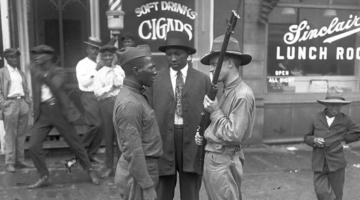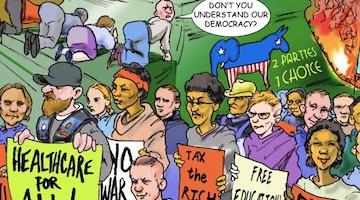Manning Marable reminds us that US fascism is institutional and normalized. The parallels of his 1981 essay with the present are obvious – US fascism remains ascendant.
What is an anatomy of American fascism? The late African-American historian Manning Marable asked this question in a two-part article titled, “The Prospects for Fascism,” published in 1981 in the New Journal and Guide, the longstanding Black newspaper from Norfolk, Virginia. Writing at the beginning of the Ronald Reagan era, Marable suggests a genealogy of US fascism that began with Lyndon B. Jonson’s escalation of the “genocidal war” in Vietnam, continued through the vicious “peanut-brained schemes and dreams” of Jimmy Carter, and appeared to be on the verge of an explosion with the rise of Reagan and the New Right in the early 1980s.
Marable’s genealogy is important. He does not argue fascism appears fully formed in the satanic presence of Ronald Reagan, but that the structural and institutional basis of US fascism had existed long before Reagan’s election, giving Reagan a platform for fascism’s intensification and expansion. Marable also argues for the exceptional nature of US fascism – an exceptionalism based on normalization. That is, US fascism does not occur through coup d’etats and the spectacle of regime change but through so-called democratic institutions. For Marable, two other characteristics are significant. First, the intensification of racism and the mainstreaming of white supremacy. Second, the consolidation of corporate power and the attack on labor and the working classes as a response to declining rates of corporate profit.
The parallels with the present are obvious; the historical continuity with the past is apparent; US fascism remains ascendant. Without further comment, we reprint Manning Marable’s “The Prospects for Fascism” below.
The Prospects for Fascism
Manning Marable
I.
The victories of the New Right in the election of 1980, combined with the revival of the Cold War abroad and racial prejudice at home, represent a new phase of American politics.
There is growing concern among the world’s progressive and Third World countries, and among the oppressed peoples of this nation, that there is something seriously wrong in the United States. A mood of racial bigotry and social intolerance which generated the neoconservative political thirst in the 1970s is maturing into an ominous and starling political movement for white power. Without exaggeration, many critics of the political scene are describing the new mood in one simple yet devastating word, fascism.
Many of us told ourselves that fascism was just around the corner during the 1960s. We saw the Johnson Administration’s genocidal war in Southeast Asia, and we denounced it as fascist. We learned about “Tricky Dick” Nixon’s Watergate burglaries, his illegal war into Cambodia, and the development of the COINTELPRO to destroy the black movement, and we declared that he was fascist. We read about Gerald Ford’s stumbling, bumbling pardon of Nixon, his cutbacks in affirmative action programs and environmental controls, and some of us called him a fascist. We endured four years of peanut-brained schemes and dreams, the revival of the Cold War, and the murder of hundreds of black women, men and children in the streets of this nation, under James Earl Carter. Some of us called him fascist. The term fascist was used so often that many people no longer listened. As in the fable of the boy who cried “wolf!”, many working and poor people were ill prepared when the real thing began to materialize.
What we must understand is that American facism will not look like anything the world has seen to date. Under a fascist regime, no wall portraits of the criminal Adolf Hitler will be in view. Mussolini and Juan Peron will not re-emerge. In fact, the formal institutions of U. S. democracy, the Congress, the Presidency and the Supreme Court, may still exist, although radically transformed. Elections will still occur, commercial television and the media will be broadcasting the same old garbage; the rhetoric of New Right will be trumpeted from the heights of governmental power and within cultural institutions, but the “appearance” of normalcy will still prevail.
Fascism is not necessarily a coup d’etat, or the overthrow of a formally elected government by the armed forces, as in Chile in 1973. Under U.S. fascism, in all probability, not a single soldier will leave the barracks.
Fascism, then, must be understood in the U.S. as a covert, rather than overt, transferral of authority into the hands of a very small fraction of racist and capitalist elites. It is the final, desperate attempt of those social forces to maintain their control over the economic and social order, at the expense of constitutional democracy.
What is an anatomy of American fascism? What are the critical variables that may comprise the nexus of white power and economic dictatorship in this country?
The first, and for our purposes, the foremost element in the drive toward U.S. Fascism, is the steady proliferation of racial violence aimed against every black person in America, regardless of income, education, or religious beliefs. This is not to minimize or to ignore the level of racist attacks aimed against our people throughout history, since we arrived in chains in 1619. Racist violence is as American as baseball, hot dogs, and apple pie. Only last year, the leader of the KKK declared that the Republican Party platform could “have been written by a Klansman.” Only last year, Ronald Reagan delivered an infamous speech in Philadelphia, Mississippi, the site of the vicious murder of three civil rights workers, that he favored a return to “states’ rights,” a favorite code word for white supremacy.
What is new during the last eighteen months or more is the massive proliferation and thinly veiled legal toleration of white racist attacks against us at every level of society.
II.
An important sign of the drift towards fascism in America is the declining rate of profitability in U.S. Corporations. The statement that even a few corporations are losing money is definitely hard for many poor people to stall. In 1980, real wages were down almost 13 percent since 1973. The official unemployment rate for black workers, which is far below the real jobless factor, increased from seven percent in 1970 to 15 percent last year.
But from 1975 to 1980, real U.S. corporate profits averaged $104.2 billion per year; from 1965-1970, the average level of real profits was $100.9 billion. In other words, the total amount of profits created, adjusted for inflation, rose three percent in ten years. During the same period, the GNP, or gross national product, which is the capitalist economy’s total output of commodities and services, rose 35 percent. Thus we see that, comparatively, the amount of profits on capital investment hasn’t kept pace. One economist estimates that the real value of corporate stocks on the Dow Jones Exchange has slumped 40 percent since 1970.
The poor economic profile means that big business is out to increase profits any way it can in the coming years. This is what all the talk about “deindustrialization” is all about. This is why Reagan received the support of David Rockefeller’s Trilateral Commission, a motley collection of corporate executives, bankers and political hacks who help rule the system. This is why the overwhelming majority of the “Fortune 500, the top capitalist firms in America, switched “from peanuts to oranges” in the 1980 election. Carter was the faithful hounding of U.S. racism and imperialism. In his own inept way he tried to see his corporate masters by rekindling the Cold War at home and abroad, slashing into the budget for social services, and creating a permanent climate of crisis. But in turning to Reagan, they turned to the wolf itself.
Reagan’s agenda for the eighties is clear: cut deeply into the real wages of workers; spend hundreds of billions of dollars to create a massive military force capable of fighting in El Salvador, Iran and Southern Africa; abandoning environmental controls; cutting health care benefits, welfare, education, food stamps, job training programs and all human-oriented service areas; pitting ethnic minorities against each other politically and socially; passing a sub minimum wage bill which will allow corporations to pay workers $2.00 an hour; creating roadblocks to thwart the unionization of the workforce; and destroying all federal regulations promoting the hiring of black and other oppressed minorities via affirmative action.
This is a classic receipt for domestic fascism. Perhaps not now, or even five years from now, but within the decade, the face of the beast will leave the shadows of reactionary rhetoric., making his presence known.
We must understand that the forces of Reaganism, racism and reaction, which converge in a growing climate of American facism and white power, will fail to deliver on its grandiose promises. Cutbacks in public services, public education, and real wages will not restore the halcyon days of the post World War II period of Pax (corporate) Americana.
If the New Right achieves power, it would not turn back the clock of history, pushing black folks in the back of the bus again. It would have to uproot and politically eliminate an entire generation of political progressives, notably within our community, but within the environmentalist, feminist, antinuclear power, and left of center activists from the middle and working classes. The final solution to the “Negro problem,” in short, would be the total elimination of the activist element within the black community.
Manning Marable’s “The Prospects for Fascism” was published in the New Journal and Guide on April 22 and 29, 1981.



















